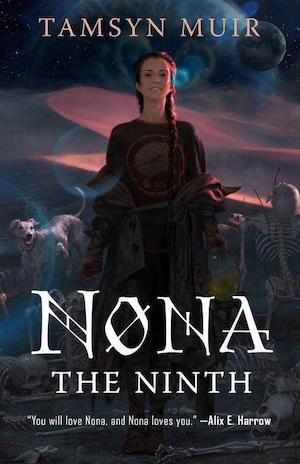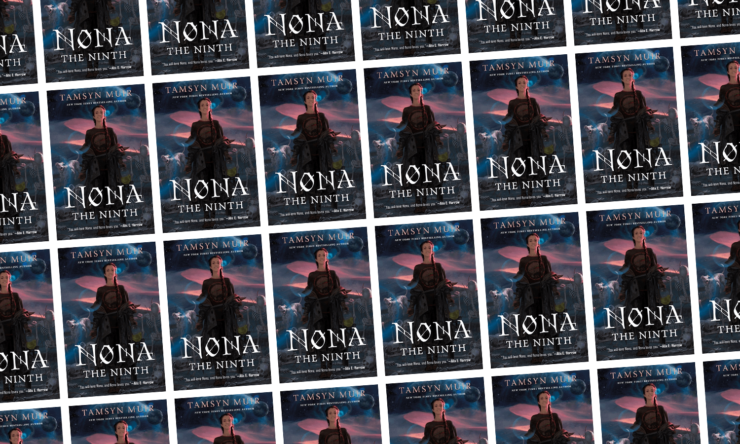Nona the Ninth.
So reads the opening page of Tamsyn Muir’s fervently-awaited third Locked Tomb novel—followed by a birthday party “Guest List” (as transcribed by C. Hect.) featuring dogs, teachers, members of the gang, and Blood of Eden soldiers; then the familiar Nine Houses refrain; and lastly an eerie poem concluding on a severed line: “You held aloft the sword. I still love y”
Needless to say, readers familiar with the psychically disruptive experience of starting Harrow the Ninth aren’t going to be shocked that Nona throws us right into the fray again.
Beginning approximately half a year after the events of the prior book, Nona alternates between hallucinatory dreaming conversations God/John has with Harrowhark… and the domestic, daily life of our (freshly-born!) titular protagonist. Though Nona’s conscious mind is only six months old, her body is an undying nineteen and she has golden eyes set in a narrow, pale face. She’s being raised by three people in two bodies, on a planet shredded by war between the Blood of Eden and the Nine House necromancers.
Buy the Book


Nona the Ninth
As you might have already guessed: yes, Muir once again knocked me over with Nona, in the best possible way. The artistic confidence that oozes from their work honestly thrills me. Muir crafts stories that demand a willingness to tumble head-first into strange, provocative worlds with our hearts pounding and brains overclocked—which I find especially exciting in a contemporary media landscape dominated by texts that don’t trust their audiences to do any heavy lifting. And Nona, like all of the Locked Tomb books, requires active engagement with both its plot-mysteries and the ethical, interpersonal quandaries it explores.
So, firstly, I’ve got to acknowledge that Nona the Ninth condenses an impossible amount of narrative and thematic work into five hundred pages. For the sake of length, as well as my own brain, this review-essay will be tackling only two concepts central the novel… but also, how Nona purposefully flips or revises our prior assumptions about those concepts within the series as a whole. They are, respectively: necropolitics and queer futurity.
Someone else can tackle the novel’s eldritch religiosity. Like, come on, we open with the chapter John 20:8—and Harrowhark wrestles constantly with the question of what it means to love god, often in the “sublime horror of holy derangement” sense. Another lucky soul might choose to gnaw on Nona‘s fuckery with genre: military thriller, coming of age story, nuclear apocalypse, domestic romance? Sure, let’s merge all of those and then some. But I was drawn most powerfully by how death, life, and desire function within the novel, as well as within the domestic unit of Nona, Camilla, Palamedes and Pyrrha.
A final warning: unavoidable major spoilers follow.
On the level of “how sovereign powers choose certain populations for death, or for a state of living death,” the dream sequences in Nona the Ninth reveal two major world-building facts. The first is what got us from contemporary earth to the necromantic frightfest of the Nine Houses: escalating climate catastrophe, hypercapitalism, and the brutal selfishness of the man who would eventually become god. The second is what lies asleep in the tomb, so far as I understood it: the enraged living soul of earth forced into a Barbie-inspired flesh body and pressed into the service of John/God.
Well, all right then.
Suddenly the vicious sterility of the death-cults readers observed throughout the prior novels seems to shapeshift. Their sacrifices and boneyards, their willingness to consume one another in raw hunger, take on a fresh awfulness. If the Nine Houses were crafted in the image of their god, a man whose greed and hubris radiate from his meandering excuses for why he sacrificially murdered his loved ones before fomenting nuclear apocalypse… then what about them that we’ve taken as normal is actually exceptionally fucked up and terrifying? What if all that cold, empty “cleanness” was—and always had been—the worst possible outcome?
In a disorienting change of pace that really drives the point home, Nona drops us from those vaunted deathworlds into the sticky, messy, throbbing aliveness of humanity. As explored by Alix E. Harrow in this delightful non-spoiler essay on the novel’s astounding “permutations of love,”
There were no children in the previous two books. There were no animals or pets, either, or fried food stands or shitty upstairs neighbors or black-market cigarettes or any of the ordinary mess of living. But Nona is positively bursting with life, from kids to rebels to six-legged dogs.
After the sterility of those first two books, simply existing in a living world feels like indulgence, like sensory excess.
For me, too, one of the coolest ways Nona centers messy life is by honing in on the myriad ways people “do” attachment and desire. While the gonzo duels and gore and monsters of the other Locked Tomb books are still present here, something else has begun to rise to the forefront: love, as terrible and immense and wonderful as it sometimes can be.
Whether familial, friendly, romantic, erotic, compassionate, chivalric, teacherly, or—ahem—several at once, relationships are what offer our characters a real sense of possibility. Suddenly, Muir’s apocalyptic queer future also has kids in it. Instead of bone castles and a generation of murdered children, war-orphans form friendship packs and pet classroom dogs together. One also can’t help but notice how there sure are a lot of structurally-significant threesomes amongst the adults.
I’ll admit, I waffle between confounded amusement and frustration with reads of the series that argue it’s chaste or otherwise nonsexual—particularly when this is presented as an unqualified positive. Needs must be said, these books are all immensely horny. Often what they’re horniest for, though, are non-normative forms of desire and intimacy. Denial and fealty, for example, carry a powerful sexy charge compelling to some readers while sailing right over the heads of others. Power dynamics are presented throughout this series as impossible to avoid in any relationship but also as potential sources of wanting, attachment, and affection. Sometimes the dynamic is a nightmare; sometimes the dynamic is generative; sometimes it’s both, or neither.
And nowhere is the prior novels’ exploration of dynamic intimacy more pointedly complicated—even reversed!—than with Palamedes and Camilla, and their eventual combination named Paul. For more than a thousand pages the lyctor’s “one flesh, one end” oath has been presented as calling for the sacrificial death and permanent consumption of the cavalier. Which is, as many others have acknowledged, an erotic-religious triangulation: the passion of mortified flesh and martyrdom combined with an ultimate, fatal way of taking a lover inside oneself. The problem is, as Harrow the Ninth showed us, that tier of sacrifice is too selfish and emotionally destructive to be borne.
Then Palamedes and Camilla, at the very end of Nona, finally discover an alternate path. By mutual sacrifice, through devotion and the combination of their selves into one balanced whole, they create an entirely new person. No one has to permanently die for their beloved to gain power—but they do both have to change. Given that the final chapter ends on Gideon and Harrow apparently each being bodies without their appropriate full souls stuffed inside them, the bound soul of a dead earth pledging herself as cavalier to Harrow (“Get in line, thou big slut,” truly made me cackle), and John/God getting a sword through the heart… well, I can’t say a damn thing for sure.
But being able to make a “Paul” instead of demanding endless, sterile consumption and death seems pretty relevant for wherever we’re going next. Time to buckle up for a surely buck-wild final installment.
Nona the Ninth is available from Tordotcom Publishing.
Read the first chapter here.
Lee Mandelo (he/they) is a writer, critic, and occasional editor whose fields of interest include speculative and queer fiction–especially where the two coincide. Summer Sons, their spooky gay debut novel, was recently published by Tordotcom, with other stories featuring in magazines like Uncanny and Nightmare. Aside from a brief stint overseas, Lee has spent their life ranging across Kentucky, currently living in Lexington and pursuing a PhD in Gender Studies at the University of Kentucky.










